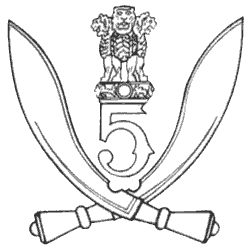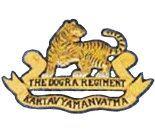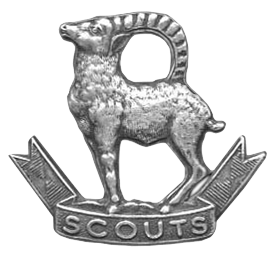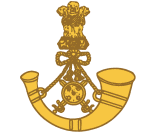 W
WThe 1st Horse is a cavalry regiment of the Indian Army, which served in the British Indian Army before independence. The regiment was raised in 1803 as Skinner's Horse by James Skinner as an irregular cavalry regiment in the service of the East India Company. It was later renamed the 1st Bengal Lancers.
 W
W1st Gorkha Rifles , often referred to as the 1st Gorkha Rifles, or 1 GR in abbreviation, is the seniormost Gorkha infantry regiment of the Indian Army. It was originally formed as part of the East India Company's Bengal Army in 1815, later adopting the title of the 1st King George V's Own Gurkha Rifles , however, in 1947, following the partition of India, it was transferred to the Indian Army and in 1950 when India became a Republic, it was redesignated as 1st Gorkha Rifles . The regiment has a long history and has participated in many conflicts, including many of the colonial conflicts prior to Indian independence, as well as the First and Second World Wars. Since 1947 the regiment has also participated in a number of campaigns against Pakistan in 1965 and 1971 as well as undertaking peacekeeping duties as part of the United Nations.
 W
WThe 3rd Gorkha Rifles or Third Gorkha Rifles, abbreviated as 3 GR is an Indian Army infantry regiment. It was originally a Gurkha regiment of the British Indian Army formed in 1815. They were present at a number of actions and wars including the Siege of Delhi in 1857 to the First and Second World Wars. After the Partition of India in 1947 the regiment was one of the six Gorkha regiments transferred to the Indian Army as part of the Tripartite Agreement signed between India, Nepal and Britain at the time of Indian independence. Prior to independence, the regiment was known as the 3rd Queen Alexandra's Own Gurkha Rifles. In 1950 the regiment's title was changed to 3rd Gorkha Rifles. Since 1947 the regiment has participated in a number of conflicts including the 1947 and 1971 wars against Pakistan.
 W
W4th Horse is a cavalry regiment of the Indian Army which originated as part of the British Indian Army.
 W
WThe 4th Gorkha Rifles or the Fourth Gorkha Rifles, abbreviated as 4 GR, is an infantry regiment of the Indian Army comprising Gurkha soldiers of Indian and Nepalese nationality, especially Magars and Gurungs hill tribes of Nepal. The Fourth Gorkha Rifles has five infantry battalions. The regiment was raised in 1857 as part of the British Indian Army. In 1947, after India's independence, the Fourth Gurkha Rifles became part of the Indian Army as the Fourth Gorkha Rifles.
 W
W5th Gorkha Rifles, also abbreviated as 5 GR(FF) is an infantry regiment of the Indian Army comprising Gurkha soldiers of Nepalese origin. It was formed in 1858 as part of the British Indian Army and served in the First World War and Second World War. The regiment was one of the Gurkha regiments that was transferred to the Indian Army following independence in 1947. The regiment was formerly known as the 5th Royal Gurkha Rifles. Since 1947, the regiment has served in a number of conflicts, including the Indo-Pakistani War of 1965 and the Indo-Pakistani War of 1971. It has also participated in peacekeeping operations in Sri Lanka.
 W
WThe 8th Gorkha Rifles is a Gorkha regiment of the Indian Army. It was raised in 1824 as part of the British East India Company and later transferred to the British Indian Army after the Indian Rebellion of 1857. The regiment served in World War I and World War II, before being one of the six Gurkha regiments transferred to the Indian Army after independence in 1947. Since then it has served in a number of conflicts including the Sino-Indian War of 1962 and the Indo-Pakistan wars of 1965 and 1971. Today the 8th Gorkha Rifles is one of the most celebrated regiments of the Indian Army, having received numerous citations for bravery in the field of battle, and even producing one of the two field marshals, Field Marshal Sam Manekshaw, of the Indian Army.
 W
WThe Deccan Horse or 9 HORSE is one of the oldest and most decorated armoured regiments of the Indian Army, which was a regular cavalry regiment of the British Indian Army, the Royal Deccan Horse. It was formed from the amalgamation of two regiments after World War I. They saw service from the Mutiny of 1857 up to and including World War II.
 W
WThe 9th Gorkha Rifles is a Gorkha regiment of the Indian Army. The regiment was initially formed by the British in 1817, and was one of the Gurkha regiments transferred to the Indian Army after independence as part of the tripartite agreement in 1947. This Gorkha regiment mainly recruits soldiers who come from the Chhetri (Khas) and Thakuri clans of Nepal. Domiciled Indian Gorkhas are also taken, and they form about 20 percent of the regiment's total strength. The 9 Gorkha Rifles is one of the seven Gorkha regiments of the Indian Army. The other regiments are 1 GR, 3 GR, 4 GR, 5 GR (FF), 8 GR and 11 GR.
 W
WThe 11 Gorkha Rifles is a Gorkha regiment of the Indian Army that was re-raised after independence. The regiment consists of primarily the Kirati Tribes Rai and Limbu of Nepal and north-eastern India. It also recruits from Indian Gorkhas and Bhutias from Darjeeling district, West Bengal and Sikkim. Though it is considered to be the youngest of the Gorkha regiments its lineage is as long as those of the 7th Gurkha Rifles and 10th Gurkha Rifles.
 W
WThe 14th Prince of Wales's Own Scinde Horse was a regular cavalry regiment of the Bombay Army, and later British Indian Army, it can trace its formation back to The Scinde Irregular Horse raised at Hyderabad on 8 August 1838. It was named after the province of Sind now in Pakistan, where it was raised to protect the trade route from the Bolan Pass to Sukkur on the Indus River and fight against the marauding Baluchi warriors. It later expanded to the 1st, 2nd and 3rd Scinde Horse. These three regiments were absorbed into the regular forces after the Mutiny of 1857 and became the 35th Scinde Horse and the 36th Jacob's Horse. They saw active service in Northern and Central India, Persia, Afghanistan on the North West Frontier and, during World War I, where they served in France and Palestine. The two regiments were amalgamated in 1922, as the present 14th Prince of Wales's Own Scinde Horse which served in World War II. Scinde Horse is the only regiment known to honour its enemy till date and has not changed its badge since its raising, unlike others who have done so-numerous times. At one point, the regiment carried 9 Standards while on parade, a unique privilege given to it for its valor. The regiment was the first Cavalry unit in the British Indian Army to get mechanized in the Indian sub-continent at Rawalpindi, in 1938. It was also the first Cavalry regiment to get the President of India's Standard post independence.
 W
WThe 16th Light Cavalry is a regiment of the Armoured Corps, a primary combat arm of the Indian Army. Prior to India gaining independence from the British in 1947, it was a regular cavalry regiment of the British Indian Army. It was formed in 1776 and is the oldest armoured regiment raised in India. The 16th Light Cavalry saw service in a number of conflicts ranging from the Second Anglo-Mysore War in 1781 to World War II. It has a number of battle honours including "Punjab 1965" earned during the Indo-Pakistani War of 1965.
 W
WThe Bengal Engineer Group (BEG) is a military engineering regiment in the Corps of Engineers of the Indian Army. The unit was originally part of the Bengal Army of the East India Company's Bengal Presidency, and subsequently part of the British Indian Army during the British Raj. The Bengal Sappers are stationed at Roorkee Cantonment in Roorkee, Uttarakhand.
 W
WThe Bikaner Camel Corps was a unit of Imperial Service Troops from India that fought for the Allies in World War I and World War II.
 W
WThe Bombay Engineer Group, or the Bombay Sappers as they are informally known, are a regiment of the Corps of Engineers of the Indian Army. The Bombay Sappers draw their origin from the erstwhile Bombay Presidency army of the British Raj. The group has its centre in Khadki, Pune in Maharashtra state. The Bombay Sappers have gone on to win many honours and awards, both in battle and in peacetime, throughout the 19th and 20th centuries, both before and after Independence. The gallantry awards won include the British Victoria Cross and the French Legion of Honour before independence, as well as the Param Vir Chakra and Ashok Chakra as part of Independent India. The Group has also made its mark in peacetime activities such as sport, adventure, disaster relief, aid to civil authority and prestigious construction projects.
 W
WThe Brigade of The Guards is a mechanised infantry regiment of the Indian Army. It was raised as the first "all India", "all class" infantry regiment of the Army where troops from all parts of India serve together, as opposed to other regiments that recruit from specific regions, ethnic groups or religions.
 W
WThe Dogra Regiment is an infantry regiment of the Indian Army. The regiment traces its roots directly from the 17th Dogra Regiment of the British Indian Army. When transferred to the Indian Army like its sister regiments, the numeral prefix was removed. Units of the Dogra Regiment have fought in all conflicts that independent India has been engaged in, making it one of the most prestigious and most decorated regiments of the Indian Army.
 W
WThe Grenadiers is an infantry regiment of the Indian Army, formerly part of the Bombay Army and later the pre-independence British Indian Army, when the regiment was known as the 4th Bombay Grenadiers. It has distinguished itself during the two world wars and also since the Independence of India. The regiment has won many battle honours and gallantry awards, and is considered to be one of India's most decorated regiments with three Param Vir Chakra awardees in three different conflicts.
 W
WThe Jammu and Kashmir Light Infantry is an infantry regiment of the Indian Army. The regimental center is in Srinagar's Airport Complex at Awantipora with a winter setup near Jammu. Its regimental insignia consists of a pair of crossed rifles. The regiment mostly consists of volunteers from the state of Jammu & Kashmir. 50% of the regiment's troops are Muslims while the rest represent other ethnic groups from the state.The Jammu and Kahmir Light Infantry is considered to be one of the most decorated regiment of the Indian army having won 1 Param Veer Chakra and 3 Ashok Chakra. Naib Subedar Chuni Lal of the 8th battalion Jammu and Kashmir Light Infantry is one of the most decorated personnel of the Indian Army.
 W
WThe Jammu and Kashmir Rifles is an infantry regiment of the Indian Army. Its origins lay in the Jammu and Kashmir State Forces of the princely state of Jammu and Kashmir. After the accession of the state to the Indian Union in October 1947, the State Forces came under the command of the Indian Army. They remained in the original form until 1956 when Jammu and Kashmir Constituent Assembly effectively ratified the state's accession to India. Then the State Forces became the Jammu and Kashmir Regiment of the Indian Army. In 1963, the designation was changed to Jammu and Kashmir Rifles. After the conversion, the Ladakh Scouts came under the aegis of the Regiment, where it remained until raised as a separate Regiment in 2002.
 W
WThe Jat Regiment is part of the infantry of the Indian Army, of which it is one of the longest-serving and most-decorated regiments. The regiment has won 19 battle honours between 1839 and 1947, and post-independence it has won five battle honours, eight Mahavir Chakra, eight Kirti Chakra, 32 Shaurya Chakras, 39 Vir Chakras and 170 Sena Medals. During its 200-year service history, the regiment has participated in various actions and operations in India and abroad, including the First and the Second World Wars. Numerous battalions of the Jat Regiment, including the 14th Murray's Jat Lancers, fought in the First World War.
 W
WThe Kumaon Regiment is the most decorated infantry regiment of the Indian Army. The regiment traces its origins to the 18th century and has fought in every major campaign of the British Indian Army and the Indian Army, including the two world wars.
 W
WThe Ladakh Scouts is an infantry regiment of the Indian Army, nicknamed the "Snow Warriors" or "Snow Tigers". The regiment specialises in mountain warfare, and its primary role is to guard India's borders in the high altitudes of the union territory of Ladakh.
 W
WMadras Engineer Group (MEG), informally known as the Madras Sappers, is an engineer group of the Corps of Engineers of the Indian Army. The Madras Sappers draw their origin from the erstwhile Madras Presidency army of the British Raj. This regiment has its HQ in Bengaluru. The Madras Sappers are the oldest of the three groups of the Corps of Engineers.
 W
WThe term Madras Pioneers related to bodies of Pioneers as well as Sappers and Miners which were part of the Madras Presidency Army.
 W
WThe Maratha Light Infantry is the oldest and light infantry regiment of the Indian Army. It traces its lineage to the Bombay Sepoys, raised in 1768, making it the most senior light infantry regiment in the Indian Army. The class composition of the regiment was and is primarily formed by Maratha recruits from the former Maratha Empire. The men are mostly drawn from all over the state of Maharashtra, with some percentage from Marathi-speaking areas of Karnataka including Coorg. The regimental centre has been in Belgaum, Karnataka, since 1922, which was part of the Bombay Presidency at that time. The battle cry of Maratha Light Infantry is, "Bola Shri Chhatrapati Shivaji Maharaj Ki Jai ". The regiment has won over 60 battle honours, including 21 in World War I.
 W
WThe Naga Regiment is an infantry regiment of the Indian Army. It is among the youngest regiments of the Indian Army - the first battalion was raised in Ranikhet in 1970. The regiment recruits mainly from Nagaland, in northeast India.
The Parachute Regiment is an airborne forces and special forces regiment of the Indian Army.
 W
WThe Poona Horse is an armoured regiment in the Armoured Corps of the Indian Army. The regiment, known before independence as The Poona Horse, was raised as a regular cavalry regiment in the Bombay Presidency army of the East India Company. It was formed from the 3rd Regiment of Bombay Light Cavalry, raised in 1820, and the Poona Auxiliary Horse, raised about 1817–18. The latter unit was absorbed into the regular forces about 1860 and the two regiments later became the 33rd Queen Victoria's Own Light Cavalry and the 34th Prince Albert Victor's Own Poona Horse.
 W
WThe Punjab Regiment is second oldest regiments still in service in the Indian Army, and is the most senior regional infantry regiment. It was formed from the 2nd Punjab Regiment of the British Indian Army in 1947 and has taken part in various battles and wars since, winning numerous honours for the same.
The Rajput Regiment is an infantry regiment of the Indian Army. It is composed primarily of troops from the Rajput, and Gurjar community. In 1945, the class composition of the regiment was 50% Rajput and 50% Muslim.
 W
WThe Rajputana Rifles is the oldest rifle regiment and one of the senior-most regiments of the Indian Army. It was originally raised in 1921 as part of the British Indian Army, when six previously existing regiments were amalgamated to form six battalions of the 6th Rajputana Rifles. In 1945 the numeral designation was dropped from the title and in 1947 the regiment was transferred to the newly independent Indian Army. Since independence, the regiment has been involved in a number of conflicts against Pakistan, as well as contributing to the Custodian Force (India) in Korea under the aegis of the United Nations in 1953-54 and to the UN Mission to the Congo in 1962. As a rifle regiment it uses a bugle horn as its insignia, the same as the British Light Division, but unlike its British counterparts, the Rajputana Rifles march at the same march pace used in the Indian Army as a whole.
 W
WThe Sikh Light Infantry is a light infantry regiment of the Indian Army. The regiment is the successor unit to the 23rd, 32nd and 34th Royal Sikh Pioneers of the British Indian Army. The regiment recruits from the Sikh community of Himachal Pradesh, Punjab and Haryana states of India. The versatility of the Sikh Light Infantry has seen the regiment conduct operations from conventional warfare on the Siachen Glacier, the highest battlefield in the world, to counter-terrorism. Units of the regiment have also been deployed as part of the United Nations Emergency Force. The regimental motto is "Deg Tegh Fateh", meaning "prosperity in peace and victory in war". The motto has great significance with the tenth Sikh guru, Guru Gobind Singh, with whom the Mazhabi community is very closely associated. The regiment's cap badge is a chakram or quoit, with a mounted kirpan. The insignia was designed to honour the Mazhabi community's Akali Nihang ancestry.
 W
WThe Sikh Regiment is an infantry regiment of the Indian Army. It is the most decorated regiment of the Indian Army and in 1979, the 1st battalion was the Commonwealth's most decorated battalion with 245 pre-independence and 82 post-independence gallantry awards, when it was transformed into the 4th battalion, Mechanised Infantry Regiment. The first battalion of the regiment was officially raised just before the annexation of the Sikh Empire on August 1 1846, by the British East India Company. Currently, the Sikh Regimental Centre is located in Ramgarh Cantonment, Jharkhand. The Centre was earlier located in Meerut, Uttar Pradesh.